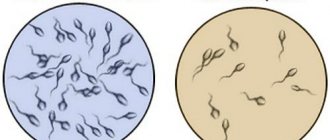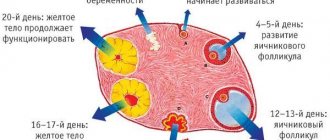What is implantation discharge?
Implantation bleeding is a slight discharge that occurs as a fertilized egg attaches to the wall of the uterus. This symptom appears no more often than 20-30%; in most women, the process of embryo attachment is completely asymptomatic.
Implantation bleeding is considered the most reliable and early sign of pregnancy, since it occurs even before a missed period.
The mechanism of its development is directly related to the structure of the uterine walls. The inner surface of the uterus is loose tissue with a large number of blood vessels. The fetus needs adequate blood circulation for normal growth and development for 9 months.
After conception, the process of embryo attachment begins, which is accompanied by damage to the uterine tissues and small blood vessels. As a result of this microtrauma, blood appears. If the microtrauma is insignificant and the blood vessels are not damaged, implantation takes place without this sign, completely unnoticed by the woman. Normally, the whole process lasts only a few days, after which the blood clotting system restores the integrity of the blood vessels and the discharge stops.
Implantation during menstruation
May 3, 01:24
Have there ever been such cases???
Girls, I was wondering, I recently read an article on the internet about “periods” during pregnancy... Continue reading →
Don't you feel pregnant?.. But it is!)
Good morning to everyone. I want to share: even if you don’t hope at all that you’re pregnant this time, you shouldn’t despair. 1) In this cycle – pregnant, in fact – my breasts completely abandoned me.
Well, that’s how it felt – no pain, nothing swollen or tingling. It even seemed to me that my breasts somehow sagged and became more flabby. 2) I missed the time of ovulation - I don’t even remember having any sensations. No YaB, nothing pulled.
I suspected that... Continue reading →
Embryo implantation: on what day is attachment carried out?
Embryo implantation: on what day is implantation carried out, and what symptoms are accompanied by this process? As a rule, seven to ten days pass from the moment of fertilization of the egg to the moment of implantation, if we take into account the day of ovulation... Continue reading →
who had this happen
Girls, help, last month there was a week delay, I took a test, there was a second noticeable line, but then my period came and there was only one line, then in the new cycle on the 13th day I went to the ultrasound specialist, he said there was no follicle and the endometrium was 5.5 mm, then on the 23rd day ,ts went to me..... Read more →
Secrets of conception and early pregnancy (Part 3)
And now I will tell you another secret of conception. Is it possible to know that a woman is pregnant even before implantation? Some women say that they feel some strange sensations inside themselves that cannot be described in words, even before the delay of menstruation.
And what, in this case, is the biochemical stage of pregnancy, when supposedly there is pregnancy, but implantation has not yet occurred? It turns out that you can know that conception has occurred literally in a matter of hours.
In 1974, the first data on the so-called early pregnancy factor appeared in the medical literature... Read more →
Highlights (sorry for such details)
Soooo, this is weird. Very, very much. In the morning I woke up with the feeling that I was leaking, it was really wet. My period, according to the calendar, promises to start on August 28. I went to pee and on my panties I saw a wet spot from discharge and a small brown spot. Pos….. Read more →
Blood after the long-awaited || stripes, is it a miscarriage or implantation?
Girls are expensive
Source: https://www.BabyBlog.ru/theme/implantaciya-vo-vremya-mesyachnyh
Signs of implantation bleeding
Implantation bleeding is a natural process that occurs without pronounced symptoms. Many women perceive it as the onset of their periods too early. The attachment of the embryo can be determined by several characteristic features:
- Character and features
- creamy or light pink shade of the discharge, without a pronounced odor. - Abundance
- most often the scarcity of discharge, in a minimal amount. - Unpleasant sensations
- in some cases, a woman may be bothered by slight painful sensations in the lower abdomen of a pulling or aching nature, or an unpleasant pulsation.
Most often, the attachment of the embryo does not affect the woman’s general well-being, but in some cases nausea, drowsiness, constant fatigue, weakness and loss of strength may occur. But such symptoms are mild and do not interfere with a woman’s daily life. Basal temperature is of no small importance - of course, if a woman measures it regularly. During the period of ovulation, which is considered the most suitable for conception, basal temperature rises.
During the attachment of a fertilized egg, which is called implantation retraction, the basal temperature drops - most often for a short time. Such fluctuations in basal temperature often become signs of pregnancy.
How to understand whether menstruation has begun or implantation occurred on the day of menstruation? 1
Pregnancy does not always proceed according to classical ideas. There are many nuances and features that can sometimes confuse a woman.
It happens that pregnancy has occurred, and spotting during this period is interpreted as critical days. In fact, this is how implantation can occur on the day of menstruation.
What it is? Are there any signs that can be used to distinguish such discharge from normal menstruation?
Concept of implantation
Fertilization (fusion of sperm and egg) can occur anywhere in the internal genital organs, but most often it happens in the fallopian tube.
After cell copulation, the developing embryo (during this period, from a histological point of view, is usually called a blastocyst) gradually moves into the uterine cavity, where the “soil” has already been prepared for it. By this time, under the influence of sex hormones, the endometrium grows.
Figuratively speaking, its surface layer becomes loose and soft so that the blastocyst can attach to the wall of the uterus.
At the moment of “implementation,” the integrity of the walls of small vessels may be disrupted, which causes bleeding of varying degrees of intensity.
This is how implantation occurs before menstruation or a little later, it all depends on the regularity of the woman’s cycle. The process of strengthening the developing embryo in the uterine wall occurs from 6 to 15 - 20 days after conception.
Simple arithmetic shows that implantation can occur exactly on the day of the expected menstruation, which misleads a woman.
Signs of implantation bleeding
Implantation of an embryo and discharge, as during menstruation - this combination occurs in 1 out of 20-25 women. This can be observed with a threatened miscarriage, also with a non-developing, ectopic pregnancy and some other conditions.
Therefore, if any bleeding appears against the background of other signs of pregnancy (positive test, nausea and vomiting, enlarged mammary glands, drowsiness, etc.), you should consult a doctor.
Only a specialist can establish the cause of this phenomenon and take the necessary measures to preserve the developing embryo without compromising the woman’s health.
Due date
Bloody discharge in 90% of cases of implantation bleeding occurs several days before the scheduled menstruation. But this is only true if a woman’s cycle is approaching 28 days.
https://www.youtube.com/watch?v=ogktJxx9pcM
If the period between critical days is longer, then the spot may appear a week or a week and a half earlier. Sometimes a woman normally has similar discharge on the eve of menstruation, but then it gradually turns into normal menstruation, as opposed to implantation.
Nature of the discharge
As a result of the attachment of the developing embryo to the wall of the uterus, small vessels are destroyed, which causes bleeding. They can be bright pink, pale bloody, streaked with blood, smearing dark brown.
Duration of discharge
In 90% of cases of pathology, the discharge lasts no more than one or two days. Sometimes at first they can be bright, and the next day they turn into brown smudges.
Number of allocations
If implantation occurs on the day of the expected menstruation, as a rule, based on the quantity, a woman may suspect a pathology.
In most cases, the discharge is insignificant, sometimes it is just “strings of blood” or a single red spot on the underwear.
That is why women do not always pay attention to such changes and do not turn to specialists in a timely manner. Copious discharge and clots are not typical for implantation bleeding.
Additional symptoms
The appearance of pain in the lower abdomen of a pulling or aching nature indicates another pathology in most cases. When a woman’s menstruation has always been accompanied by discomfort and pain, then if implantation occurs during menstruation, there will be no such manifestations.
Also, if conception has occurred, after a few days the girl may be bothered by engorgement and an increase in the size of the mammary glands, and the nipples become sensitive. Sometimes nausea, changes in eating behavior, drowsiness and lethargy appear. All these are early signs of pregnancy, and, accordingly, the discharge is not menstruation, but the result of implantation.
Also, if the expectant mother keeps a graph of basal temperature, she will immediately notice a stable increase above 37 throughout the days. The pregnancy hormone progesterone is responsible for this.
Causes of discharge
After fertilization, the blastocyst seeks a place for attachment in order to further form the chorion, and then the placenta. Every month, the endometrium inside the uterine cavity prepares for the upcoming event. In cases where conception still does not occur, its upper layers peel off and come out along with menstrual blood.
When pregnancy has occurred, the endometrium, loose and full-blooded, is ready for implantation of the blastocyst and accepts it.
The developing embryo secretes special enzymes that “dissolve” the attachment site deeper. As a result, the integrity of the vascular wall is compromised, mostly in the capillaries.
As a result, a small amount of blood is released from the uterine cavity through the cervix to the outside.
How not to confuse it with menstruation
Can implantation coincide with menstruation? Yes, indeed, in most cases this process occurs several days before the expected critical days or exactly on schedule.
In order not to confuse menstruation and discharge associated with the process of implantation of the fertilized egg into the endometrial layer, you should be attentive to your own feelings. It is also recommended to keep a menstrual calendar, where each time the girl notes the days of sexual intercourse, the beginning and end of the cycle, as well as the nature and amount of discharge.
Then menstruation proceeds as usual, and a few days after it a slight discharge appears, which the woman may mistake for residue. She will find out about pregnancy directly by the delay next month. As a rule, in such cases there is always a difference in the timing of ultrasound and menstruation.
In any case, if you suspect pregnancy, you should do a test. But in such a short period of time it will very rarely show reliable results. Therefore, if in doubt, it is recommended to take a blood test for hCG. It gives reliable results within 10 days from the moment of conception.
We recommend reading the article about menstruation during pregnancy. From it you will learn about normal and pathological discharge during conception, the reasons for the appearance of discharge, the effectiveness of a pregnancy test during menstruation.
Embryo implantation after menstruation or on the eve of it is a process of the physiological course of pregnancy. Normally, it should not be accompanied by any, especially bloody, discharge.
However, in approximately 5 - 10% of women during this period, a dubious pink or brownish daub appears, which cannot always be noticed, especially with an “imperfect” cycle.
A timely contact with a specialist will help resolve all problems and controversial issues.
Source: https://ProMesyachnye.ru/implantaciya-v-den-mesyachnyx/
Changes in the female body
The attachment of a fertilized egg becomes a serious stress for the female body. From the first minutes of conception, all biochemical processes are actively rearranged to suit the new “interesting position”. From this moment, progesterone begins to be produced - a hormone that stops menstruation and ensures further growth of the endometrium. This is why pain appears, as during menstruation during implantation.
During the period of attachment of a fertilized egg, a woman’s immunity sharply decreases. This is necessary so that the female body does not perceive the embryo as a foreign body. Otherwise, immune cells begin to produce special antibodies, which can cause spontaneous abortion.
Most often, with successful fertilization, implantation bleeding appears 3-8 days before the expected period or on the first day of menstruation.
But it must be taken into account that the secretion can also be released during an ectopic pregnancy. In this case, pain and other unpleasant symptoms appear more pronounced than during normal pregnancy. The only way to reliably determine an ectopic pregnancy is ultrasound.
Differences from menstruation
There are several characteristic differences that can be used to distinguish implantation from regular menstruation.
- Volume - when the egg is attached, the discharge is very scanty throughout the entire time, lasting no more than 2-3 days. During menstruation they are abundant and last up to 4-8 days.
- Menstruation is characterized by an uneven character - scanty bleeding turns into intense bleeding and ends with scanty bleeding.
- Menstruation differs from implantation bleeding in time - if the former most often begin on the 27-30th day of the menstrual cycle, then the latter 4-7 days after ovulation (3-8 days before menstruation).
- Implantation is characterized by the appearance of creamy-milky or pink smudges with barely noticeable blood streaks. During menstruation they are a rich red color.
A special feature of menstruation is premenstrual syndrome, which affects many women. It is accompanied by weakness, loss of strength, nervousness, tearfulness and increased irritability. It begins a few days before menstruation and can be accompanied by unpleasant, painful sensations in the lower abdomen, as well as swelling of the mammary glands.
How to find out about pregnancy if you have your period?
So, we have dealt with the question of whether a girl can be pregnant during her period and what symptoms arise. The time has come to find out how to confirm the fact of conception. Let's try to answer this question. The first thing you should pay attention to is the nature of the bleeding. As a rule, critical days with an interesting situation last less, and the nature of the discharge is distinguished by its scarcity.
Already in the first weeks, the expectant mother may feel characteristic signs. These include:
- Morning sickness and malaise.
- Dizziness.
- Frequent mood changes.
- Increased or, conversely, decreased appetite.
- Dyspeptic disorders (stool disorders, flatulence, heartburn, belching).
If a girl encounters such manifestations, she should definitely undergo a medical examination, even if the test shows a negative result. The hospital will require the following tests:
- Analysis of urine. Reliable results can be obtained within 2-3 weeks after conception.
- Ultrasound of the pelvic organs. This method will not only be able to identify the embryo, but also exclude other conditions that cause problems with the woman’s health (cysts, tumors, ectopic attachment of the embryo).
- Blood test for hCG. This method makes it possible to detect the presence of pregnancy in the early stages with a high probability.
If the interesting situation is confirmed, the expectant mother needs to register with a doctor.
In case of unwanted conception or the presence of contraindications to bearing a baby, an artificial termination of pregnancy is performed.
Main features of implantation
In order to distinguish implantation bleeding from regular menstruation, you need to take into account its main features.
- The timing of the onset of implantation secretion does not coincide with the menstrual cycle and begins on days 23-27. It depends on its duration, but they always start before your period.
- The appearance of implantation bleeding may be accompanied by mild, aching or nagging pain in the lower abdomen.
- The duration of such bleeding, unlike menstruation, does not exceed 2-3 days.
- When a fertilized egg is implanted, the secretion is scanty, light pinkish in color, without a pronounced odor.
- During fertilization, the process of hormonal changes begins in the female body, which “adapts” to the new position. This process may be accompanied by emotional instability, tearfulness, and irritability.
Hormonal changes in the body also affect the condition of the mammary glands. They increase slightly in size, the nipples become sensitive, and their color becomes darker.
After embryo implantation, menstruation may begin
The site provides reference information for informational purposes only. Diagnosis and treatment of diseases must be carried out under the supervision of a specialist. All drugs have contraindications. Consultation with a specialist is required!
Embryo implantation
the process of its attachment to the uterus is called. In this case, the embryo “grows” into the mucous membrane of the uterus, which ensures its further development and the formation of a full-fledged fetus. To understand the mechanisms of embryo implantation, certain knowledge of the anatomy of the female genital organs and the physiology of reproduction is required.
An embryo can only be formed by the fusion of a male reproductive cell ( sperm)
) with a female reproductive cell (
ovum
).
Each of these cells contains 23 chromosomes responsible for transmitting genetic information.
During fertilization, the chromosomes of male and female germ cells combine, resulting in the formation of one complete cell ( zygote
), which contains 23 pairs of chromosomes.
Under natural conditions, this process proceeds as follows.
During ovulation, an egg that is ripe and ready for fertilization leaves the ovary and moves into the fallopian tube ( connecting the uterine cavity with the ovaries
), where it remains for about a day.
If, while the egg is in the fallopian tube, it is fertilized by a sperm, this will lead to the formation of a zygote.
The resulting zygote begins to divide, that is, first 2 cells are formed from it, then 3, 4, 5 and so on. This process takes several days, during which the number of cells in the developing embryo increases.
Some of the resulting cells accumulate inside the embryo, and some - outside ( around
) them.
The inner part is called the "embryoblast" ( from which the embryo will develop
), while the cells surrounding the embryoblast are called "trophoblast".
It is the trophoblast that is responsible for the process of implantation of the embryo and its nutrition throughout the entire period of intrauterine development.
During the process of division, the embryo
) gradually moves from the fallopian tube into the uterine cavity, after which the process of its implantation begins. The essence of this process is as follows. First, the embryo attaches to the surface of the uterine mucosa.
In this case, peculiar villi ( threads)
), which grow into the mucous membrane and begin to produce specific substances that destroy it. As a result of this, a kind of depression is formed in the mucous membrane of the uterus, into which the embryo is immersed.
Subsequently, the mucosal defect closes, as a result of which the embryo is completely immersed in it. At the same time, trophoblast threads continue to penetrate the uterine tissue, receiving nutrients and oxygen directly from the maternal blood.
This ensures the process of further development of the embryo.
What does it look like and when can there be signs of implantation?
Implantation bleeding is scarce - it can be either a few drops, which are almost impossible to see on underwear, or spotting. If a woman does not regularly measure her basal temperature, she will not notice its fluctuations, since they do not affect her general well-being.
Women perceive unpleasant cramps in the lower abdomen, weakness and tearfulness as manifestations of PMS. It should be borne in mind that manifestations of implantation are possible only in the case of unprotected sexual intercourse during ovulation. Only a combination of such factors allows us to talk about conception.
Most often, such discharge occurs 4-6 days after successful conception.
This depends on individual characteristics and the duration of the menstrual cycle. For many women, bleeding during implantation occurs on days 23-26 of the cycle, so most perceive such discharge as a harbinger of upcoming menstruation.
How long do they last?
Most often, if there is any pathology, discharge may appear within 1-2 days. At first they may have a bright scarlet color, but a little later they become brown and smudged. When implanted during menstruation, heavy discharge may appear, which will be very similar to normal regular discharge.
- Weakness during menstruation
- What does bloating during menstruation mean?
- Diarrhea during menstruation - the cause of diarrhea
- What to do if your period falls on New Year's holidays
Differences from ectopic bleeding
An ectopic pregnancy is a condition that poses a serious danger not only to reproductive health, but also to a woman’s life. It is also accompanied by bleeding, which has its own specific characteristics.
The main differences between discharge during ectopic pregnancy:
- most often have a brown tint - this is explained by the fact that the blood is released from distant areas and, when removed from the body, already has time to darken;
- with an ectopic pregnancy, they are accompanied by sharp, stabbing pains;
- minor bleeding can suddenly give way to heavy bleeding.
Women need to take into account that signs of implantation are never too abundant or prolonged. They last from several hours to 3 days. If you experience sharp, stabbing pain, you should definitely consult a gynecologist, since an ectopic pregnancy poses a serious danger to women’s reproductive health.
In what cases should you consult a doctor?
Manifestations of implantation are almost impossible to confuse with menstruation, but they can be a sign of other pathological conditions and dangerous diseases - hormonal imbalances, inflammatory or infectious processes in the female body. Most often, in such cases, the symptoms continue for more than 2-3 days; inclusions of blood or mucus can be seen in the discharge. The pain, loss of strength and discomfort are so severe that they disrupt the woman’s normal daily life.
The problem may be due to other reasons:
- installation of an intrauterine device;
- mechanical injuries to the uterus and its cervix, as well as the vaginal cavity as a result of overly aggressive sexual intercourse;
- ectopic pregnancy.
If bleeding is accompanied by severe pain and lasts more than 3 days, you should definitely consult a gynecologist. Only a doctor can determine the cause of the problem by conducting all the necessary examinations and tests.
What else can it be confused with?
Scanty vaginal bleeding can be a sign of not only implantation and other diseases and conditions.
| Cause | Additional signs |
| Ectopic pregnancy | Bleeding that is bright red or brown, with sharp, stabbing pain that lasts |
| Inflammatory diseases | Painful sensations of varying intensity, increased body temperature, purulent discharge, loss of strength |
| Endometriosis | Blood smearing appears after sexual intercourse or physical activity |
| Uterine fibroids | Bleeding with blood clots, accompanied by painful cramps in the lower abdomen |
| Cancer of the uterus or ovaries | Painful sensations in the lower abdomen, weakness, loss of strength, increased body temperature |
Also, this problem may be associated with hormonal disorders in the female body. They are accompanied by weight fluctuations, hair loss or increased hair growth, sudden changes in blood pressure and sleep disturbances.











